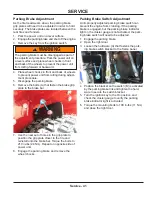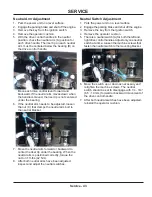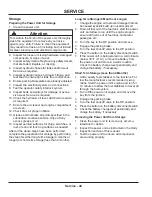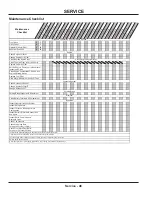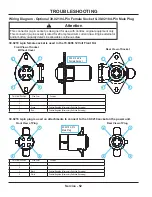
SERVICE
Service - 38
Jump Starting Procedure
1.
DANGER
The battery produces a flammable and explosive
gas. The battery may explode.
• Wear eye protection and gloves.
• Do not jump start a cold or frozen battery. Allow
the battery to warm up and inspect for cracks
or damage.
• Do not jump start a cracked or damaged battery.
• Do not attempt to jump start the power unit
using a battery of a different voltage.
Inspect the discharged battery for terminal corro-
sion and loose connections. Clean terminals and
tighten connections prior to jump starting.
2. Make sure the vehicle used to jump start the
power unit has a 12 volt, negative ground, elec-
trical system.
3. Pull the boosting vehicle up close to the disabled
power unit. Be sure the vehicles do not touch.
4. Shut off the boosting vehicle’s engine and set
the parking brake.
5.
CAUTION
Attempting to start the disabled unit with the
boosting vehicle’s engine running could cause
damage to the regulator.
7
8
6
5
2
4
3
1
A
B
C
D
E
F
G
H
I
J
K
1
2
3
4
B
A
C
A. Discharged Battery
B. Booster Battery
C. Ground Stud
Connect one end of the positive (+) booster cable
to the discharged battery’s positive (+) terminal (1).
6. Connect the other end of the positive (+)
booster cable to the booster battery’s positive
(+) terminal (2).
7. Connect the negative (-) booster cable to the
booster battery’s negative (-) terminal (3).
8. Connect the other end of the negative (-) booster
cable to the disabled power unit’s ground stud (4).
9. Start the disabled power unit and remove the
booster cables in reverse order of installation
(negative booster cable first).
Replacing Fuses
1. Park the power unit on a level surface.
2. Engage the parking brake and shut off the engine.
3. Remove the key from
A
the ignition switch.
4. Press the button on
the battery disconnect
switch.
5. Open the right door.
6. Remove the cover (A)
from the fuse panel.
7. Identify and pull the
defective fuse from the
socket. Fuse positions
are printed on the fuse
panel cover.
8.
Fuse Panel
Position
Fuse
Circuit
1
5 amp
USB / Cluster Gauge
2
10 amp
Ignition Switch
3
30 amp
Fuse Block Distribution
4
25 amp (CB) Hydraulic Cooling Fan
5
10 amp
Work Lights
6
15 amp
Operation Interlock System
7*
10 amp
PTO
8*
15 amp
Brine Pump
9
30 amp
Voltage Regulator
10*
10 amp
12 Volt Aux. Hydraulics
11*
20 amp
12 Volt 4-Pin Front
12
10 amp
Starter / Hyd. Cooler Relay
13*
10 amp
Spreader
14
-
Spare
15
-
Spare
16
-
Spare
*Optional accessory.
(CB) = Circuit Breaker
Insert a new fuse into the
socket. Be sure to use the correct amperage
fuse or damage may occur to the power unit.
9. Reinstall the sealed cover onto the fuse panel
and close the right door.
10. Reset the battery disconnect switch.


















